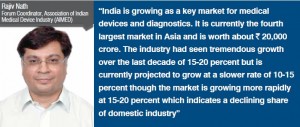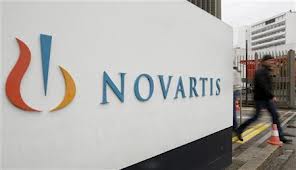 India holds the position of largest medical device market in Asia and the market has been growing consistently well despite the troublesome regulatory environment. A closer look!
India holds the position of largest medical device market in Asia and the market has been growing consistently well despite the troublesome regulatory environment. A closer look!
By Sharmila Das, ENN

Indian medical device market has been growing at an impressive rate and experts feel it will continue to grow at 15 percent in the coming years. The medical device fraternity comprise of manufacturers, distributors, buyers like different hospital chains, stand alone pathology labs, diagnostics centers and the like. Arindam Sen, CEO, Advanced Micronic Devices Ltd, subsidiary of Opto Circuits (I) Ltd says, The medical device market in BRIC (Brazil, Russia, India and China) countries account for nearly USD 10 billion and is growing at an annual rate of 8 percent.
Wholesome picture
Sen gives the ground reality of the different compliances of medical device regulations in India by saying, The medical device segment is primarily dominated by the diagnostics segment. In India, a medical device manufacturer can legally sell medical devices in the domestic market, post meeting compliance parameters as per the Indian medical device regulations.


He adds further, Prior to 2005, there were no regulations for medical devices in India. Today, there are registration procedures for certain classes of medical devices regulated under the provisions of the Drugs and Cosmetics Rules. Comprehensive legislation governing medical devices is pending. Currently India has no specific regulations for medical devices. They are freely imported into India, except for implantable devices, critical diagnostic kits and sterile devices, which are required to be registered.
Rakshith Shetty, CEO & Managing Director, Fanem Medical Devices India Pvt Ltd says, Today the regulation is more to do with radiation, Indian FDA for drugs,BIS and electrical safety It is true that we have more than one body to regulate Medical Devices. But I am afraid none other than BARC has really put an effort to get the manufacturers/ traders to be more responsible in manufacturing,import X-ray and other radiation equipments. The other bodies are not in a regulation mode but have been more harassment to both the local manufacturers and the importers of medical devices. It is also true that most countries around the world, where regulations have had a strong hand in protecting the market, have been benefitted. BARC is very clear with the regulation and this helps the complete industry to make better products and also trade with products which are reliable. I hope to see this kind of regulation from BIS.
Suresh Shammugan, Manger-Finance, Vin Biotech shares, We need more ethical and financial institutions as you know, we dont have any. India doesnt have any big manufacturing sector in medical equipments, small units are there. China and other countries have very hitech technology but in India, we dont have. However, can be developed in constitution with Government bodies and private companies.

For medical device manufacturers to legally sell medical devices within India, they need to be in compliance with Indian medical device regulations. Currently, manufacturers of medical devices which require registration can leverage their approvals in the US, Canada, Europe, Australia or Japan to register their medical devices in India. During the medical device registration process, the primary entity to work with is the Medical Devices Division of the CDSCO. The hierarchy of medical device regulatory entities in India
is as follows:
a) Ministry of Health and Family Welfare- Drug Controller General of India – DCG (I), b) Central Drugs Standard Control Organisation (CDSCO – Medical Devices Division).
However, with the nonavailability of medical device regulations in India the manufacturers are in catch 22 situation. They neither can overlook the demand that the industry throws at them nor do they completely make use of the situation. Hence they suffer. Sen says, It is challenging for the Indian manufacturers to grow in this framework. With an absence of a regulation or standard certification process for manufacture of medical equipment in India, companies do not receive international certifications such as US FDA and or CE mark. Hence face the challenge of low credibility thereby making it difficult to compete with international players within the country as well as expanding to other countries.
Nonavailability of standard medical device regulations in India has been a drawback. Its been posing a slow growth in demand for the domestic players, hence predominant awareness and acceptance for its international peers. The regulatory environment for medical technology in India is ambiguous, complex and lacks transparency. Absence of specific regulation for the industry has resulted in lack of clarity and transparency about the regulations. There are problems pertaining to multiple levels of Government authority involved in enforcing the guidelines, as well as inconsistent interpretation and application of the regulatory guidelines by customs officials at the ports, state drug controllers, and officials within CDSCO. This results in a prolonged and cumbersome regulatory pathway, especially for new products. Lack of regulation of the industry has also resulted in products of sub-standard quality being brought into the market, creating wider gaps of quality and cost within the same category of products; which also creates significant risk for the consumer.
Expert recommendations
Rajiv Nath, Forum Coordinator, Association of Indian Medical Device Industry (AIMED) says, India is growing as a key market for medical devices and diagnostics. It is currently the fourth largest market in Asia and is worth about `20,000 crore. The industry had seen tremendous growth over the last decade of 15-20 percent but is currently projected to grow at a slower rate of 10- 15 percent though the market is growing more rapidly at 15-20 percent which indicates a declining share of domestic industry. Hence now is the time for a policy review so that domestic industry growth exceeds 20-25 percent by increasing its share in the domestic and international market.
Sen says, As Indias burden of disease transitions from communicable to non communicable diseases (NCD) driven by socio-economic advancements, medical devices will play a critical role in helping the Government to diagnose and treat NCDs. For the industry to maximise its reach, scale and potential to address Indias healthcare needs, the Government needs to create a supportive enabling environment. This would require the establishment of a new regulatory regime for medical devices and diagnostics products with focus on Safety, Quality and Efficacy. Currently, the Indian healthcare scenario is characterised by lack of standardisation and ambiguity on regulatory standards. A lot has been achieved in terms of optimal regulation for Pharmaceutical Industry and the same needs to be replicated for Medical Devices and healthcare delivery sector. Proper regulation can help the industry positively by harmonising it with rest of the world, though with local needs in consideration. Its imperative to have a separate regulatory body equipped to understand and uate medical devices.
Shetty says, The regulatory bodies have to issue a protocol to all the medical devices manufacturing companies to achieve the required certifications in the coming two years. Also make a support system to help bigger companies to get certified as they will have a high market share and they would want to inform the market about the superiority of their products. This will make the complete market prepared to face the future. My recommendation would be to have a registration of each type of equipment because; this will ensure that when the new equipments are introduced in the market, the product has all the recomcremended safety standards. The MCI and DCI should recognise the products based on some certifications that the educational institutes can buy. This will reduce the impact on the young doctors who are so used to looking at non-functional equipments in their educational institutions, that they end up with low skills of managing equipments. When trained under bad products, the impact is very long term. Many institutions have looked at only fulfilling the requirements and not actually looked at what they are buying.
Guidelines for import
India has not been able to develop itself as a strong manufacturing base for medical technology. The industry remains dependent on imports for meeting its domestic requirements. There are two key factors contributing towards this trend. One is that the Government
has not been proactive in encouraging the development of a domestic manufacturing industry. There are no specific incentives in place to attract local or foreign companies to set up a production base in India. Secondly the current duty structure for medical devices and equipments favours imports, reducing the competitiveness and growth potential of the local medical technology industry.
For now, its all important to look at these aspects and solve the bothering situations.
Be a part of Elets Collaborative Initiatives. Join Us for Upcoming Events and explore business opportunities. Like us on Facebook , connect with us on LinkedIn and follow us on Twitter , Instagram.












